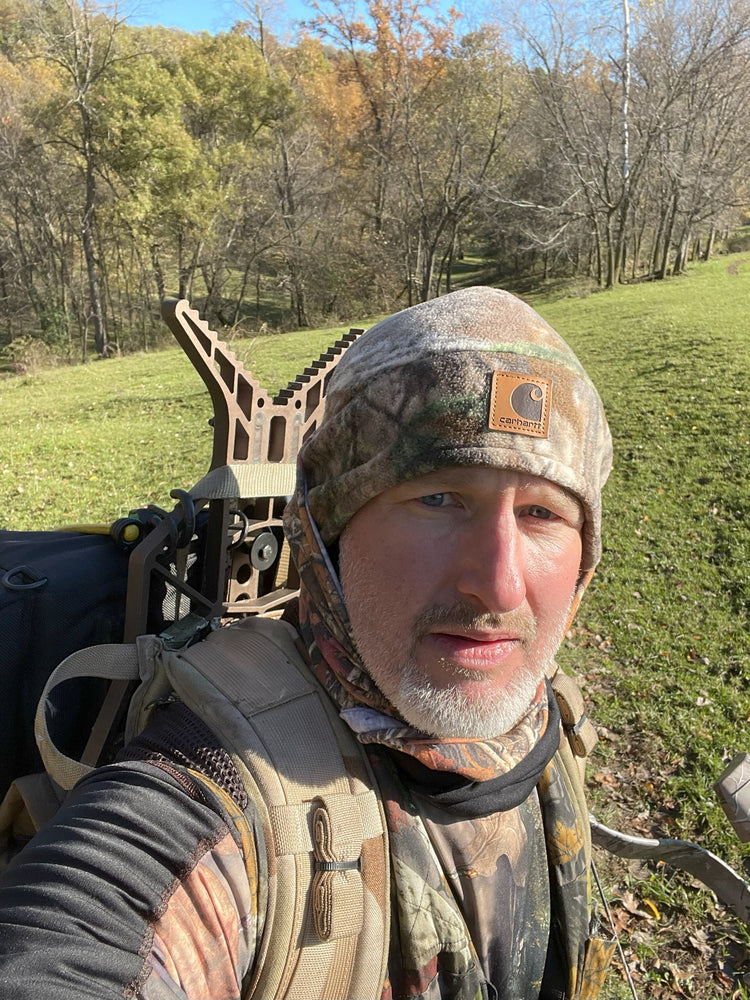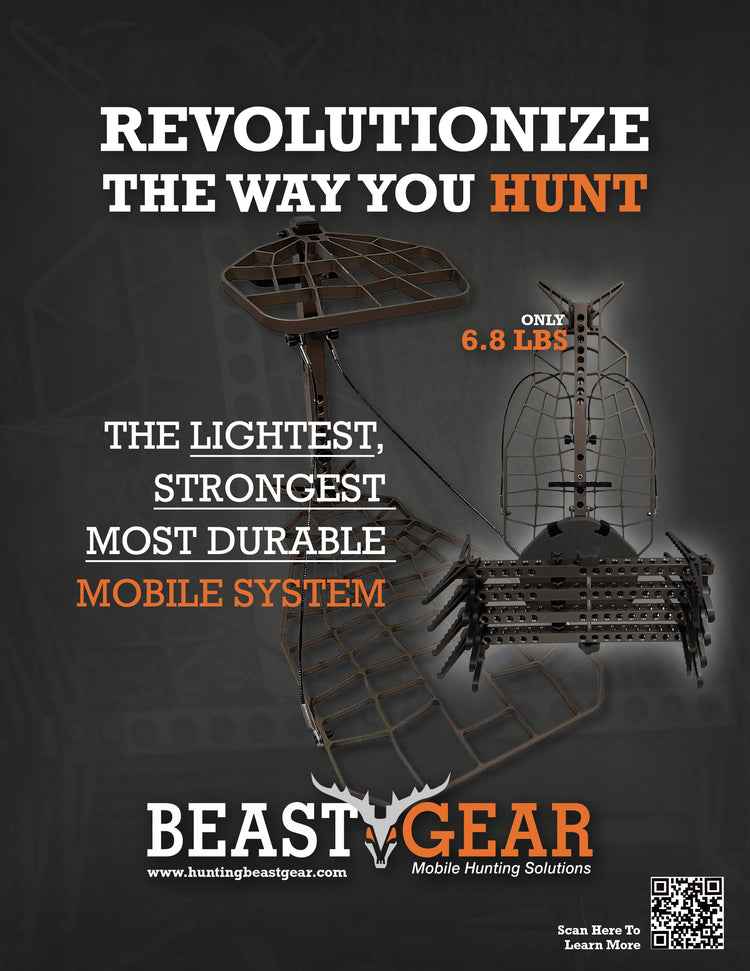One of the great things about mobile hunting is that you can quickly make adjustments in a variety of terrain to hunt down a mature Whitetail deer utilizing not only your out of season scouting but the sign you encountered on your hunts.
From a young age I’ve enjoyed challenging myself physically. That became more focused as I began to learn and do more sports specific training. Over time I’ve adopted a variety of different training styles focusing on strength, endurance, flexibility, and sports specific techniques.
Without a doubt being physically fit can be a key component in your hunting success. Many of the areas I end up hunting in require a certain amount of physical challenge to hunt. This is less by design and just more of a reality of the areas and topography I find mature Whitetails.
If I’m able to navigate challenging terrain without being overly physically taxed, this becomes a key factor in my state of “focus” or “flow” as I am in the moment of the hunt where I’m not simply walking to a location but scanning my surroundings for sights, sounds, and smells that may be a key piece in a mature Whitetail’s puzzle. My goal is to keep my mind focused on my surroundings as opposed to directly on the physical tax being placed on my body.
Over the years I’ve shifted my training to joint stability, core strength, flexibility, and sustained endurance. I have my fair share of wear and tear on my body after many years of competing in and coaching the sport of wrestling. Because of this I wanted to spend more time bullet proofing my knees, hips, low back, and shoulders for my hunts.
In looking at my hunts I like to break them down into 6 phases (ASESRP) that require me to be in peek physical condition.
- Access: As you become more mobile in your hunting style, you will find yourself walking through a variety of topographies in hill country, farm country, swamps, and marshes where you’re extending your hips, knees, and back through a full range of motion under load on un-even ground and through natural obstacles
- Set-Up: In most cases this includes executing a steady and calculated climb while setting up your equipment utilizing strength, stability, and flexibility in your knees, hips, back, and shoulders.
- Encounter: Quite often the goal of your hunt is to engage with that target animal, having a lower resting heart rate due to exercise can counteract the spike in heart rate one may experience when encountering your target animal. The same physiological pathways activated during intense physical exercise can help train your mental focus, control your physical response, and ultimately keep you calm when it matters most.
- Shot: The shot often requires precise timing, movement, and decision making all while potentially staring down the buck of a lifetime. This can send a rush of neurochemicals into your bloodstream triggering a response from your central nervous system resulting in an elevated heart rate, erratic muscle twitching, and erratic breathing. A daily training regime can help exercise and regulate your response, again keeping you calm when it matters most.
- Recovery: Following the shot, you often need to recover your deer. This can require focused decision making, while still dealing with the mental and physical response of the encounter and shot. Being in peak physical condition can allow you to rapidly return to a calm resting heart rate, as well as allow you to remain mentally focused during elevated adrenaline levels, something you often experience during intense physical exercise.
- Pack-out: Once you’ve located your buck one often has a mix of mental and physical responses ranging from relief to extreme excitement. This can once again tax the body’s central nervous system triggering a rush of energy and/or fatigue. Those who are in peak physical condition will make a quick recovery from this mix of mental and physical stressors. There mind and body will be adequately conditioned for the physical task of packing out the kill.
As you can see, I am a firm believer that physical fitness plays a key role in my overall hunting experience. Here are some exercises I perform as part of my regular workout regime that aid in my overall goals of joint stability, core strength, flexibility, and sustained endurance.
Many of these exercises can be found on @kneesovertoesguy or @kneesovertoesguy for more information on the overall benefit of the exercises. I provided some links below for alternate sites where these exercises can be viewed.
- Reverse Sled Pulls: I perform this exercise at varying levels of intensity 3-4 times a week. I focus on steady pace and positioning versus doing heavy weight. In a typical session I will pull between 125 – 150 lbs. for 20 yards for 8-10 reps.
- Reverse Nordics: I perform this exercise 2-3 times a week typically with my body weight only. This works on quadricep, knee joint, and ankle joint strength and flexibility. Ease into this one with a spotter or something that can support your body weight as you fall back into position.
- Split Squats: I perform this exercise 3-4 times a week. I start with my body weight only then gradually work my way up in weight while maintaining stability. This really works on knee stability and strength for navigating uneven ground.
- Weighted Hip Flexion: I perform this exercise 2-3 times a week, I utilize ankle weights, or a cable machine to add weighted resistance to this exercise. Strengthening my hip flexors helps with my overall range of motion with climbing and stepping over obstacles while hunting.
- Pull-Ups: I perform this exercise 3-4 times a week, alternating my grips from overhand to underhand to neutral on rings. Doing a strict 8-12 reps for 5 sets depending on grip works best for me.
- Sprinting: During my workouts I like to be constantly moving. Again, I want to simulate a good mix of aerobic and anaerobic training as hunting mobile can tax the body in both ways. My sprints range in distance from 25-40 yards, followed by a brief recovery, followed by a circuited weight training exercise, followed by another sprint. This takes my body and mind through exertion, and recovery in rapid cycles allowing me to work on calming my mind and heart rate while preparing for the next exercise. The sprints also help me continue to elongate my hamstrings, him flexors, and gluts by focusing on my form and stride length. All of this helps with my mobility and endurance on challenging terrain features.
There is a wealth of information out there for anyone looking to train on a regular basis, my best advice is just to be consistent. Breaking a sweat every day is a habit that will undoubtedly have an exponential impact on your overall mental and physical health.
thanks



Great info! Loading up a backpack with the weight of your gear or more then you usually carry and going for a 1-2mile walk is a good lower intensity day also. I use a climbing stand alot and focus on dips alot thid time of the year.